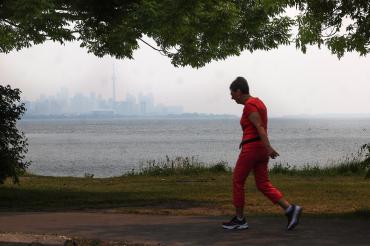Tips from an exercise physiologist on how to stay fit safely when air quality is poor

(photo by Steve Russell/Toronto Star via Getty Images)
Published: June 8, 2023
The air in Toronto and across parts of North America has become so polluted due to forest fires in Quebec and Ontario that Environment Canada recently issued an air-quality advisory, suggesting people with asthma or heart disease, older adults and children wear a face mask when outside to reduce exposure to smoke particles. In response, many organizations have decided to reschedule outdoor activities or move them indoors.

Ira Jacobs, a professor of exercise physiology in the University of Toronto's Faculty of Kinesiology & Physical Education and the director of the Tanenbaum Institute for Science in Sport, spoke with faculty writer Jelena Damjanovic about how everyday fitness and exercise routines can be modified to suit such conditions. Jacobs’ area of expertise includes physiological responses and adaptations to environmental extremes.
Should we exercise outside when the air is smoky from wildfires? What are the risks?
The short answer is no. The main issues of concern are the absolute amount and size of the particles in the air that are associated with both acute respiratory health risks, as well as accumulating increases in those risks with repeated exposures.
The other important aspect is our body’s ventilation rate – how much air is being drawn into our lungs. When it comes to the effects of the forest fires on our outdoor air quality during the last few days … the news is actually fairly bad. Reports indicate that over 90 percent of the air particulate content of forest fire smoke consists of very fine particles that are about less than 2.5 microns in size (about 40-50 times smaller than a grain of sand). The smaller the particulate size, the deeper down into our lungs that those particles can be drawn and deposited. And the deeper they go, the greater the pulmonary/respiratory health risks.
The health risks are compounded because most of us become primarily “mouth breathers” when we exercise, so some of the body’s natural particulate trapping and filtering mechanisms in the nasal cavity become ineffective at the high ventilation rates that we generate during exercise – at least 10 times the normal resting ventilation rates, and much higher for athletes who are training or competing.
What’s a good alternative?
Much of the problem is avoided – or significantly reduced – by exercising indoors, particularly in more recently constructed buildings that are well sealed and where the indoor air is recirculated and cooled as part of the recirculation process. Some large older buildings draw in outdoor air continuously and cool it after it has been drawn into the building – so given today's air-quality challenges, it’s good to know what the status of the air circulation is wherever you’re exercising indoors.
Even in this worst-case scenario, appropriate filters can be installed to trap the particulate matter of concern. In summary, for now and until the air quality index improves, exercise in a air-conditioned building or at home.
For those not easily dissuaded, are there any adjustments they can make to reduce the risks of exercising outdoors?
Reducing the duration of exercise at high ventilation rates will commensurately reduce the risk.
And wearing a respirator like a N95 that traps particulate matter that is less than 2.5 microns in size is also effective, but admittedly not very pleasant on a warm day. And some people find that a respirator or any face mask seriously impedes the ability to maintain the kind of exercise intensities that high-performance athletes need to maintain their training effects.



